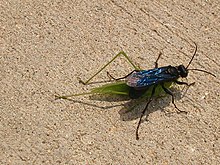Sphex
| Sphex | |
|---|---|
 |
|
| Sphex pensylvanicus on a katydid | |
| Scientific classification | |
| Kingdom: | Animalia |
| Phylum: | Arthropoda |
| Class: | Insecta |
| Order: | Hymenoptera |
| Family: | Sphecidae |
| Subfamily: | Sphecinae |
| Tribe: | Sphecini |
| Genus: |
Sphex Linnaeus, 1758 |
| species | |
|
More than 130; see text |
|
More than 130; see text
Wasps of the genus Sphex (commonly known as digger wasps) are cosmopolitan predators that sting and paralyze prey insects. Sphex is one of many genera in the old digger wasp family Sphecidae (sensu lato), though most apart from the Spaciness have now been moved to the family Crabronidae. There are over 130 known Sphex species.
In preparation for egg laying, they construct a protected "nest" (some species dig nests in the ground, while others use pre-existing holes) and then stock it with captured insects. Typically, the prey are left alive, but paralyzed by wasp toxins. The wasps lay their eggs in the provisioned nest and the wasp larvae feed on the paralyzed insects as they develop.
The great golden digger wasp (Sphex ichneumoneus) is found in North America. The developing wasps spend the winter in their nest. When the new generation of adults emerge, they contain the genetically programmed behaviors required to carry out another season of nest building. During the summer, a female might build as many as six nests, each with several compartments for her eggs. The building and provisioning of the nests takes place in a stereotypical, step-by-step fashion.
Sphex has been shown, as in some Jean Henri Fabre studies, not to count how many crickets it collects for its nest. Although the wasp instinctively searches for four crickets, it cannot take into account a lost cricket, whether the cricket has been lost to ants or flies or simply been misplaced. Sphex drags its cricket prey towards its burrow by the antennae; if the antennae of the cricket are cut off, the wasp would not think to continue to pull its prey by a leg.
The navigation abilities of Sphex were studied by the ethologist Niko Tinbergen.Richard Dawkins and Jane Brockmann later studied female rivalry over nesting holes in Sphex ichneumoneus.
Some writers in the philosophy of mind, most notably Daniel Dennett, have cited Sphex's behavior for their arguments about human and animal free will.
...
Wikipedia
